【BZOJ 2618】 2618: [Cqoi2006]凸多边形 (半平面交)
2618: [Cqoi2006]凸多边形
Description
逆时针给出n个凸多边形的顶点坐标,求它们交的面积。例如n=2时,两个凸多边形如下图:则相交部分的面积为5.233。
Input
第一行有一个整数n,表示凸多边形的个数,以下依次描述各个多边形。第i个多边形的第一行包含一个整数mi,表示多边形的边数,以下mi行每行两个整数,逆时针给出各个顶点的坐标。
Output
输出文件仅包含一个实数,表示相交部分的面积,保留三位小数。
Sample Input
2
6
-2 0
-1 -2
1 -2
2 0
1 2
-1 2
4
0 -3
1 -1
2 2
-1 0Sample Output
5.233HINT
100%的数据满足:2<=n<=10,3<=mi<=50,每维坐标为[-1000,1000]内的整数
半平面交模板:(终于缩到100行以内了。。。之前没删调试恶心的180+)
#include<cstdio>
#include<cstdlib>
#include<cstring>
#include<iostream>
#include<algorithm>
#include<cmath>
using namespace std;
#define Maxn 1100 struct P
{
double x,y;
P() {x=y=;}
P(double x,double y):x(x),y(y){}
friend P operator - (P x,P y) {return P(x.x-y.x,x.y-y.y);}
friend P operator + (P x,P y) {return P(x.x+y.x,x.y+y.y);}
friend P operator * (P x,double y) {return P(x.x*y,x.y*y);}
friend double operator * (P x,P y) {return x.x*y.y-x.y*y.x;}
friend double operator / (P x,P y) {return x.x*y.x+x.y*y.y;}
}a[Maxn];
struct L
{
P a,b,v;double slop;
friend bool operator < (L a,L b) {return (a.slop!=b.slop)?(a.slop<b.slop):a.v*(b.b-a.a)>;}
friend P inter(L a,L b)
{
P nw=b.a-a.a;
double tt=(nw*a.v)/(a.v*b.v);
return b.a+b.v*tt;
}
friend bool jud(P x,L c) {return c.v*(x-c.a)<;}
}l[Maxn],q[Maxn];int cnt,tot; void ffind()
{
for(int i=;i<=cnt;i++) l[i].v=l[i].b-l[i].a,l[i].slop=atan2(l[i].v.y,l[i].v.x);
sort(l+,l++cnt);
int L=,R=;
tot=;
for(int i=;i<=cnt;i++)
{
if(l[i].slop!=l[i-].slop) tot++;
l[tot]=l[i];
}
cnt=tot;tot=;
q[++R]=l[];q[++R]=l[];
for(int i=;i<=cnt;i++)
{
while(L<R&&jud(inter(q[R-],q[R]),l[i])) R--;
while(L<R&&jud(inter(q[L+],q[L]),l[i])) L++;
q[++R]=l[i];
}
while(L<R&&jud(inter(q[R-],q[R]),q[L])) R--;
while(L<R&&jud(inter(q[L+],q[L]),q[R])) L++;
q[R+]=q[L];
for(int i=L;i<=R;i++) a[++tot]=inter(q[i],q[i+]);
} void init()
{
int n;
scanf("%d",&n);
cnt=;
for(int i=;i<=n;i++)
{
int m;
scanf("%d",&m);
P ft,now,nw;
scanf("%lf%lf",&ft.x,&ft.y);
now=ft;
for(int j=;j<=m;j++)
{
scanf("%lf%lf",&nw.x,&nw.y);
l[++cnt].b=nw,l[cnt].a=now;
now=nw;
}
l[++cnt].a=now;l[cnt].b=ft;
}
} void get_area()
{
double ans=;
for(int i=;i<tot;i++) ans+=a[i]*a[i+];
ans+=a[tot]*a[];
if(tot<) ans=;
printf("%.3lf\n",ans/);
} int main()
{
init();
ffind();
get_area();
return ;
}
【分析】
然而只是想做一道半平面交的模版题,就从星期二打到了现在。。。【下午还要考试呢真是无爱。。
这题是求凸包的交,我们可以把每一条线段转化半平面,求半平面交。
对于半平面交,最朴素的想法应该是两两线段求交点,然后判断是否在每一个平面内,然后求凸包吧(感觉奇慢无比啊)
而事实上,如果有n的半平面的话,半平面交的答案那个凸包不会超过n条边,因为每个半平面最多只贡献一条边,说明我们事实上做了很多很多无用功。
根据凸包的思想,我们觉得半平面交也是有单调性的。
那个nlogn的算法可以看zzy的论文《半平面交的新算法及其实用价值》。
半平面共用向量表示,向量的左边为有效半平面。
定义半平面的极角为表示半平面的向量的极角。
根据半平面的极角进行排序,若两个半平面极角相同,明显只需要保存最靠左的半平面,根据这个去重。
然后这样做:
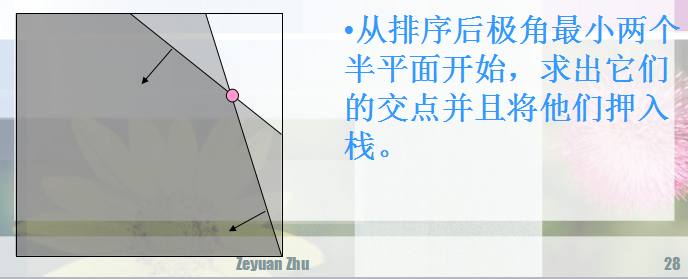
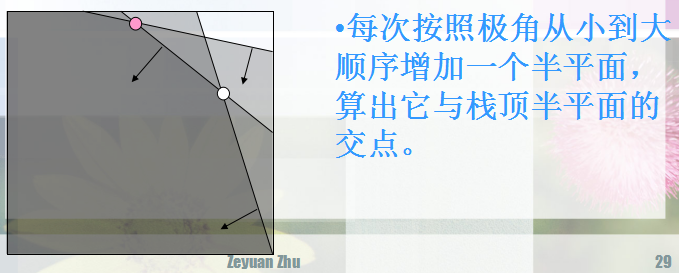

跟单调队列差不多,两边判断,删减。
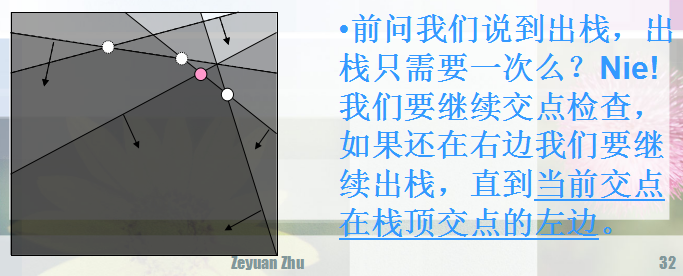
注意最后还要判断一下,去尾。像这样:
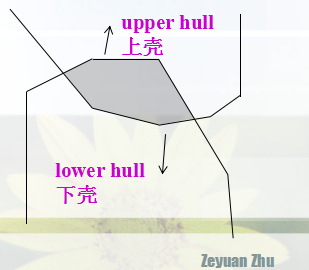

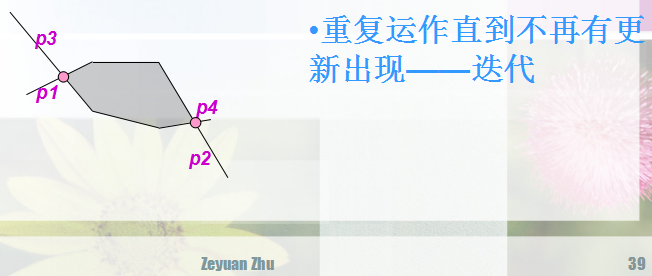
这题就是这样了。
放代码(调试很多,不删了)
#include<cstdio>
#include<cstdlib>
#include<cstring>
#include<iostream>
#include<algorithm>
#include<cmath>
using namespace std;
#define Maxn 1100 struct P {double x,y;};
struct L {P a,b;double slop;}l[Maxn];
//半平面只方向向量a->b的左部分
//slop 极角
int cnt; P operator - (P x,P y)
{
P tt;
tt.x=x.x-y.x;
tt.y=x.y-y.y;
return tt;
} P operator + (P x,P y)
{
P tt;
tt.x=x.x+y.x;
tt.y=x.y+y.y;
return tt;
} double Dot(P x,P y) {return x.x*y.x+x.y*y.y;}
double Cross(P x,P y) {return x.x*y.y-x.y*y.x;}
// bool operator < (L x,L y) {return x.slop<y.slop;} bool operator < (L a,L b)
{
if(a.slop!=b.slop)return a.slop<b.slop;
return Cross(a.b-a.a,b.b-a.a)>;
} P operator * (P X,double y)
{
P tt;
tt.x=X.x*y;
tt.y=X.y*y;
return tt;
} P a[Maxn];
L q[Maxn];
int tot; P inter(L a,L b)
{
P X=a.a-a.b,Y=b.a-b.b,nw;
double tt;
nw=b.a-a.a;
tt=Cross(nw,X)/Cross(X,Y);
P ans=b.a+Y*tt;
return ans;
} bool jud(L a,L b,L c)
{
P p=inter(a,b);
return Cross(c.b-c.a,p-c.a)<;
} void opp()
{
for(int i=;i<=cnt;i++)
{
printf("%.2lf %.2lf %.2lf %.2lf = %.2lf \n",l[i].a.x,l[i].a.y,l[i].b.x,l[i].b.y,l[i].slop);
}
printf("\n");
} void output()
{
for(int i=;i<=tot;i++) printf("%2lf %.2lf\n",a[i].x,a[i].y);
printf("\n");
} void op(int L,int R)
{
for(int i=L;i<=R;i++)
printf("%lf %lf %lf %lf\n",l[i].a.x,l[i].a.y,l[i].b.x,l[i].b.y);
printf("\n");
} void ffind()
{
for(int i=;i<=cnt;i++)
l[i].slop=atan2(l[i].b.y-l[i].a.y,l[i].b.x-l[i].a.x);
sort(l+,l++cnt); // opp(); int L=,R=;
//去重?
tot=;
for(int i=;i<=cnt;i++)
{
if(l[i].slop!=l[i-].slop) tot++;
l[tot]=l[i];
}
cnt=tot;tot=;
// opp();
q[++R]=l[];q[++R]=l[];
for(int i=;i<=cnt;i++)
{
while(L<R&&jud(q[R-],q[R],l[i])) R--;
while(L<R&&jud(q[L+],q[L],l[i])) L++;
q[++R]=l[i];
// op(L,R);
}
while(L<R&&jud(q[R-],q[R],q[L])) R--;
while(L<R&&jud(q[L+],q[L],q[R])) L++;
q[R+]=q[L];
for(int i=L;i<=R;i++)
a[++tot]=inter(q[i],q[i+]);
// output(); // output();
} void init()
{
int n;
/*scanf("%d",&n);
for(int i=1;i<=n;i++)
{
scanf("%lf%lf%lf%lf\n",&l[i].a.x,&l[i].a.y,&l[i].b.x,&l[i].b.y);
}
cnt=n;*/
scanf("%d",&n);
cnt=;
for(int i=;i<=n;i++)
{
int m;
scanf("%d",&m);
P ft,now;
scanf("%lf%lf",&ft.x,&ft.y);
now=ft;
for(int j=;j<=m;j++)
{
P nw;
scanf("%lf%lf",&nw.x,&nw.y);
l[++cnt].b=nw;
l[cnt].a=now;
now=nw;
}
l[++cnt].a=now;l[cnt].b=ft;
// opp();
} for(int i=;i<=cnt;i++)
l[i].slop=atan2(l[i].b.y-l[i].a.y,l[i].b.x-l[i].a.x);
// opp(); } void get_area()
{
double ans=;
for(int i=;i<tot;i++)
{
ans+=Cross(a[i],a[i+]);
}
ans+=Cross(a[tot],a[]);
if(tot<) ans=;
printf("%.3lf\n",ans/);
} int main()
{
init();
ffind();
// output();
get_area();
return ;
}
用向量法求两直线的交点:

本质就是用面积比表示线段比。
P inter(L a,L b)
{
P X=a.a-a.b,Y=b.a-b.b,nw;
double tt;
nw=b.a-a.a;
tt=Cross(nw,X)/Cross(X,Y);
P ans=b.a+Y*tt;
return ans;
}
半平面交核心过程:
q[++R]=l[1];q[++R]=l[2];
for(int i=3;i<=cnt;i++)
{
while(L<R&&jud(q[R-1],q[R],l[i])) R--;
while(L<R&&jud(q[L+1],q[L],l[i])) L++;
q[++R]=l[i];
}
if(L<R&&jud(q[R-1],q[R],q[L])) R--;
代码的具体实现其实没有分上壳和下壳,是一起做的,每次保存有用的半平面,最后相邻的求交点形成凸包。
最后也不用处理上面去尾的情况了,但是注意加一句if,判断最后加的那个半平面是有效的。
:if(L<R&&jud(q[R-1],q[R],q[L])) R--;
【倒是对几何画板越来越熟练了,捂脸= =
2016-12-24 09:48:20
【BZOJ 2618】 2618: [Cqoi2006]凸多边形 (半平面交)的更多相关文章
- bzoj 2618: [Cqoi2006]凸多边形 [半平面交]
2618: [Cqoi2006]凸多边形 半平面交 注意一开始多边形边界不要太大... #include <iostream> #include <cstdio> #inclu ...
- 洛谷 P4196 [CQOI2006]凸多边形 (半平面交)
题目链接:P4196 [CQOI2006]凸多边形 题意 给定 \(n\) 个凸多边形,求它们相交的面积. 思路 半平面交 半平面交的模板题. 代码 #include <bits/stdc++. ...
- BZOJ - 2618 凸多边形 (半平面交)
题意:求n个凸多边形的交面积. 半平面交模板题. #include<bits/stdc++.h> using namespace std; typedef long long ll; ty ...
- bzoj 2618 2618: [Cqoi2006]凸多边形(半平面交)
2618: [Cqoi2006]凸多边形 Time Limit: 5 Sec Memory Limit: 128 MBSubmit: 656 Solved: 340[Submit][Status] ...
- 2018.07.04 BZOJ 2618 Cqoi2006凸多边形(半平面交)
2618: [Cqoi2006]凸多边形 Time Limit: 5 Sec Memory Limit: 128 MB Description 逆时针给出n个凸多边形的顶点坐标,求它们交的面积.例如n ...
- bzoj 2618 半平面交模板+学习笔记
题目大意 给你n个凸多边形,求多边形的交的面积 分析 题意\(=\)给你一堆边,让你求半平面交的面积 做法 半平面交模板 1.定义半平面为向量的左侧 2.将所有向量的起点放到一个中心,以中心参照进行逆 ...
- bzoj 2618【半平面交模板】
#include<iostream> #include<cstdio> #include<algorithm> #include<cmath> usin ...
- 【BZOJ2618】[CQOI2006]凸多边形(半平面交)
[BZOJ2618][CQOI2006]凸多边形(半平面交) 题面 BZOJ 洛谷 题解 这个东西就是要求凸多边形的边所形成的半平面交. 那么就是一个半平面交模板题了. 这里写的是平方的做法. #in ...
- [CQOI2006]凸多边形(半平面交)
很明显是一道半平面交的题. 先说一下半平面交的步骤: 1.用点向法(点+向量)表示直线 2.极角排序,若极角相同,按相对位置排序. 3.去重,极角相同的保留更优的 4.枚举边维护双端队列 5.求答案 ...
随机推荐
- PHP学习笔记 - 进阶篇(3)
PHP学习笔记 - 进阶篇(3) 类与面向对象 1.类和对象 类是面向对象程序设计的基本概念,通俗的理解类就是对现实中某一个种类的东西的抽象, 比如汽车可以抽象为一个类,汽车拥有名字.轮胎.速度.重量 ...
- 简单快速的伪Fractional Cascading
Fractional Cascading算法是用于将零散的多个数组(亦可理解成比较高维的空间)中的数据的二分查找速度增加,用的是空间换时间的方法.然而这种方法并不是很好懂,而且中文文献很少.在这里介绍 ...
- Trie树入门及训练
什么叫Trie树? Trie树即字典树. 又称单词查找树,Trie树,是一种树形结构,是一种哈希树的变种.典型应用是用于统计,排序和保存大量的字符串(但不仅限于字符串),所以经常被搜索引擎系统用于文本 ...
- 【Linux】rsync同步文件 & 程序自启动
rsync使用 1. 为什么使用rsync? rsync解决linux系统下文件同步时, 增量同步问题. 使用场景: 线上需要定时备份数据文件(视频资源), 使用rsync完成每天的增量备份. 参见: ...
- Excel导入功能
一:前端 <t:dgToolBar title="Excel题库导入" icon="icon-search" onclick="question ...
- Asp.net 引用css/js资源文件
注意Page.ResolveUrl之前的双引号,不是单引号 <script type="text/javascript" src="<%= Page.Reso ...
- Java执行命令行脚本
百度到的 Process p=Runtime.getRuntime().exec("C:\\test.cmd"); ProcessBuilder processBuilder=ne ...
- delphi调用 java 的 WebService服务端.
// InvRegistry.RegisterInvokeOptions(TypeInfo(ModelADServicePortType), ioLiteral); InvRegistry.Regis ...
- C++程序员笔试复习概要(一)
第8章 类和对象的创建 [内容提要] 类和对象 构造函数和析构函数 对象数组与对象指针 静态成员 友元 静态函数 虚函数 [重点与难点] 8.1 类和对象 8.1.1 类的定义 类实质上是用户 ...
- Mac OS X 10.10 Yosemite PHP 5.5.14 free type support fix
通过将php将至5.4来勉强支持freetype扩展,不推荐此方法 after upgrading to new Mac OS X Yosemite, i noticed that free type ...
